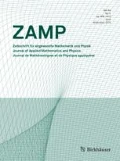Abstract
We derive gradient-flow formulations for systems describing drift-diffusion processes of a finite number of species which undergo mass-action type reversible reactions. Our investigations cover heterostructures, where material parameter may depend in a nonsmooth way on the space variable. The main results concern a gradient-flow formulation for electro-reaction–diffusion systems with active interfaces permitting drift-diffusion processes and reactions of species living on the interface and transfer mechanisms allowing bulk species to jump into an interface or to pass through interfaces. The gradient flows are formulated in terms of two functionals: the free energy and the dissipation potential. Both functionals consist of a bulk and an interface integral. The interface integrals determine the interface dynamics as well as the self-consistent coupling to the model in the bulk. The advantage of the gradient structure is that it automatically generates thermodynamically consistent models.
Similar content being viewed by others
References
Albinus G., Gajewski H., Hünlich R.: Thermodynamic design of energy models of semiconductor devices. Nonlinearity 15(2), 367–383 (2002)
Bandelow U., Gajewski H., Hünlich R.: Fabry-perot lasers: thermodynamics based modeling. In: Piprek, J. (ed) Optoelectronic Devices: Advanced Simulation and Analysis, pp. 63–85. Springer, Berlin (2005)
Bandelow U., Hünlich R., Koprucki T.: Simulation of static and dynamic properties of edge-emitting multiple-quantum-well lasers. IEEE J. Sel. Top. Quantum Electron. 9, 798–806 (2003)
Desvillettes L., Fellner K.: Exponential decay toward equilibrium via entropy methods for reaction-diffusion equations. J. Math. Anal. Appl. 319, 157–176 (2006)
De Groot S., Mazur P.: Non-Equilibrium Thermodynamics. Dover, New York, NY (1984)
Érdi P., Tóth J.: Mathematical Models of Chemical Reactions. Theory and Applications of Deterministic and Stochastic Models. Princeton University Press, Princeton, NJ (1989)
Feinberg M., Horn F.J.M.: Chemical mechanism structure and the coincidence of the stoichiometric and kinetic subspaces. Arch. Ration. Mech. Anal. 66(1), 83–97 (1977)
Gajewski H., Gröger K.: Initial boundary value problems modelling heterogeneous semiconductor devices. In: Schulze, B.-W., Triebel, H. (eds) Surveys on Analysis, Geometry and Mathematical Physics, vol. 117 of Teubner-Texte zur Mathematik, pp. 4–53. Teubner, Leipzig (1990)
Gajewski H., Gröger K.: Reaction-diffusion processes of electrically charged species. Math. Nachr. 177, 109–130 (1996)
Glitzky A., Gröger K., Hünlich R.: Free energy and dissipation rate for reaction diffusion processes of electrically charged species. Appl. Anal. 60, 201–217 (1996)
Glitzky A., Gärtner K.: Energy estimates for continuous and discretized electro-reaction-diffusion systems. Nonlinear Anal. 70, 788–805 (2009)
Glitzky A., Hünlich R.: Energetic estimates and asymptotic for electro-reaction-diffusion systems. Z. angew. Math. Mech. 77(11), 823–832 (1997)
Glitzky A.: Analysis of a spin-polarized drift-diffusion model. Adv. Sci. Appl. 18, 401–427 (2008)
Glitzky A.: Exponential decay of the free energy for discretized electro-reaction-diffusion systems. Nonlinearity 21, 1989–2009 (2008)
Glitzky A.: Energy estimates for electro-reaction-diffusion systems with partly fast kinetics. Discret. Continuous Dyn. Syst. A 25, 159–174 (2009)
Glitzky A.: Uniform exponential decay of the free energy for Voronoi finite volume discretized reaction-diffusion systems. Math. Nachr. 284, 2159–2174 (2011)
Glitzky A.: Analysis of electronic models for solar cells including energy resolved defect densities. Math. Methods Appl. Sci. 34, 1980–1998 (2011)
Glitzky, A.: An electronic model for solar cells including active interfaces and energy resolved defect densities. WIAS preprint 1663 (2011, submitted)
Gröger K.: Asymptotic behavior of solutions to a class of diffusion-reaction equations. Math. Nachr. 112, 19–33 (1983)
Jordan R., Kinderlehrer D., Otto F.: The variational formulation of the Fokker–Planck equation. SIAM J. Math. Anal. 29(1), 1–17 (1998)
Mielke A.: A gradient structure for reaction-diffusion systems and for energy-drift-diffusion systems. Nonlinearity 24, 1329–1346 (2011)
Mielke, A.: Thermomechanical modeling of energy-reaction-diffusion systems, including bulk–interface interactions. Discret. Continuous Dyn. Syst. Ser. S. WIAS preprint 1661 (2012, to appear)
Otto F.: Dynamics of labyrinthine pattern formation in magnetic fluids: a mean-field theory. Arch. Ration. Mech. Anal. 141(1), 63–103 (1998)
Otto F.: The geometry of dissipative evolution equations: the porous medium equation. Commun. Partial Differ. Equ. 26, 101–174 (2001)
Stangl R., Leendertz C., Haschke J.: Numerical simulation of solar cells and solar cell characterization methods: the open-source on demand program AFORS-HET. In: Rugescu, R.D. (ed) Solar Energy, pp. 319–352. INTECH, Croatia (2010)
Vlad M.O., Ross J.: Thermodynamically based constraints for rate coefficients of large biochemical networks. WIREs Syst. Biol. Med. 1, 348–358 (2009)
Wegscheider R.: Über simultane Gleichgewichte und die Beziehungen zwischen Thermodynamik und Reaktionskinetik homogener Systeme. Z. Phys. Chemie 39, 257–303 (1902)
Author information
Authors and Affiliations
Corresponding author
Rights and permissions
About this article
Cite this article
Glitzky, A., Mielke, A. A gradient structure for systems coupling reaction–diffusion effects in bulk and interfaces. Z. Angew. Math. Phys. 64, 29–52 (2013). https://doi.org/10.1007/s00033-012-0207-y
Received:
Revised:
Published:
Issue Date:
DOI: https://doi.org/10.1007/s00033-012-0207-y




